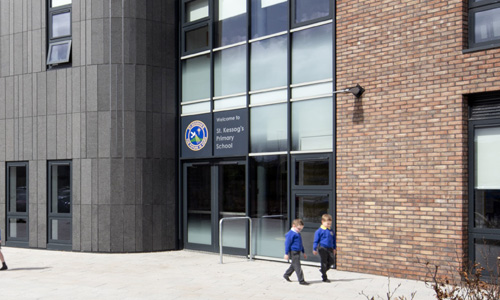Balloch Campus: Schools and Community Buildings
Location: Balloch, West Dunbartonshire
SPA Partner: West Dunbartonshire Council
SPA Appointed Company: Morgan Sindall Group
Modern learning environment for 750 pupils
In 2015, West Dunbartonshire Council confirmed over £15M of investment in a new purpose-built education campus in Balloch. The campus would incorporate two primary schools, an early learning and childcare centre, an additional support needs education centre, and shared all-weather sports facilities. Morgan Sindall, an Appointed Company on the SCB1 Framework, was selected for this major undertaking to create a modern learning environment with a capacity for nearly 750 pupils.
The new 53,280 square feet campus was completed on time and to budget with the SPA’s Framework playing a significant role in successful delivery.
Bringing the community together
The Balloch Campus enabled three existing schools to come together. Jamestown and Haldane primary schools merged into one, while St Kessogs – whose original building was demolished for the new campus – retained its name and Roman Catholic identity. The additional support needs centre is entirely new facility capable of supporting 36 pupils with a wide range of needs.
Each of the schools had their own individual requirements and interests so ongoing stakeholder engagement was a significant part of the project. The SCB1 Framework facilitated good engagement through clear and early definition of the campus design, which all parties including West Dunbartonshire Council, the schools, the designers, and Morgan Sindall, could collaborate on and sign up to.
The Framework particularly enabled Morgan Sindall to control the development of the design with their appointed design team and ensure that educational drivers were addressed at the same time as other considerations including buildability, efficiencies, and interfaces.
Utilising new technology
Another area of successful collaboration was BIM. Morgan Sindall worked with the consultant team to ensure all members of the project worked to a collaborative model environment. They utilised a BIM Information Manager to federate and QAR check the models from the key consultants and supply chain.
This meant a lower risk of clashes occurring on site, better coordination between design elements and greater efficiency in the build process. It also allows the opportunity to manufacture and assemble off-site components (e.g. service spines, lighting, and heating rafts), reducing time on site and improving quality of the product installations.
For West Dunbartonshire Council, this meant individual stages could be signed off and approved efficiently. There was far more agreements in advance than is typical in projects of this scale. As a by-product of the team working collaboratively within a model environment, Morgan Sindall were also able to produce high quality 3D images of the spaces to assist the user understanding of them. They took this further by rendering 360 virtual reality (WR) images for use with VR headsets within the spaces. This allowed staff, students, and Local Authority Management, the opportunity to stand inside the building as a shell and visualise in 3D the fully populated space around them.
“Using the virtual reality goggles with both our project team, senior officers, including of chief officer of education was very, very well received. It made sure that people who are not as used to interpreting plans could see it first hand from the BIM model. The engagement with the pupils and the schools means that we’ve got a very excited client body here, we can’t wait to get in the door.” - Lesley Woolfries, Project Manager West, West Dunbartonshire Council.
SPA’s SCB1/2 Framework has been successfully renewed as PB3 Public Buildings Framework, which is valid until September 2023.

